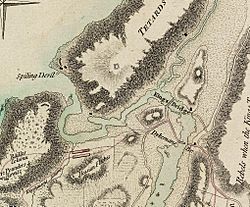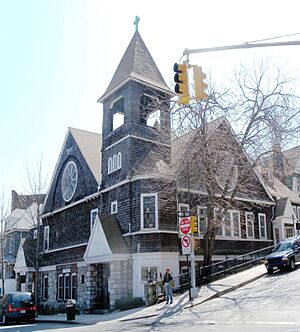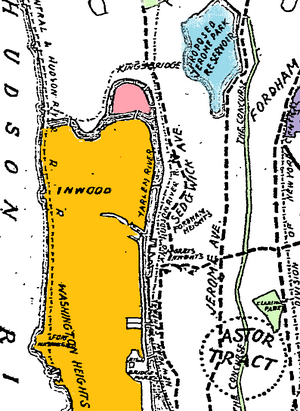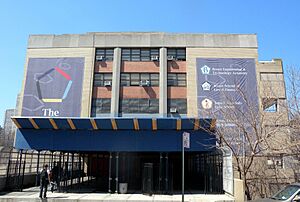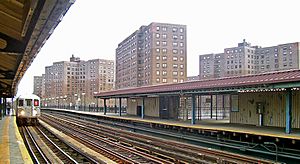Marble Hill, Manhattan facts for kids
Quick facts for kids
Marble Hill
|
|
|---|---|
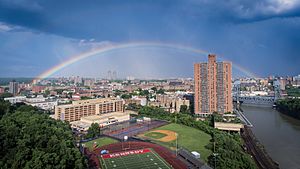
An overview of Marble Hill seen from the west with John F. Kennedy High School (foreground) and the rest of Marble Hill (center) bound by the Harlem River (on right, the site of the Harlem Ship Canal), and The Bronx (background)
|
|
| Country | |
| State | |
| City | New York City |
| Borough | Manhattan |
| Community District | Bronx 8 |
| Founded | 1891 |
| Named for | Local deposits of dolomitic marble quarried for federal buildings in lower Manhattan when New York was the capital of the United States in the 1780s. |
| Area | |
| • Total | 0.38 km2 (0.145 sq mi) |
| Population
(2010)
|
|
| • Total | 9,481 |
| • Density | 25,250/km2 (65,390/sq mi) |
| Economics | |
| • Median income | $44,096 |
| ZIP Code |
10463
|
| Area code | 718/347/929, and 917 |
Marble Hill is a neighborhood in New York City. It is the northernmost part of the Manhattan borough. Even though it was once physically connected to Manhattan Island, it became separated in 1895.
Today, The Bronx surrounds Marble Hill on its west, north, and east sides. The Harlem River forms its southern border. The area was first settled by the Dutch in 1646. It got its name, Marble Hill, in 1891 because of the Tuckahoe marble found underneath it.
Marble Hill became an island when the Harlem Ship Canal was built in 1895. This canal cut it off from Manhattan Island. Later, in 1914, the old Harlem River channel north of Marble Hill was filled in. This connected the neighborhood to the Bronx with land.
Because of these changes, Marble Hill is often linked with the Bronx. It uses a Bronx ZIP Code (10463) and Bronx area codes 718, 347, and 929. It is also served by Bronx police and fire departments. However, it is still officially part of Manhattan. The Broadway Bridge connects it to the rest of Manhattan.
Contents
History of Marble Hill
Early Settlements
People have lived in Marble Hill since the Dutch colonial times. In 1646, the Dutch governor gave a land grant for this area. Later, a ferry service was set up across the Spuyten Duyvil Creek. This creek was shallow enough for people to walk across, avoiding the ferry toll. In 1669, the ferry moved to the northern tip of Marble Hill.
Bridges Connecting the Area
Two important bridges connected Marble Hill to the mainland. The King's Bridge was built in 1693 by Frederick Philipse. He was a Dutch nobleman who owned a lot of land. His toll bridge helped people travel and settle his lands. It also carried the Boston Post Road.
In 1758, the Dyckman Free Bridge was built by Jacob Dyckman and Benjamin Palmer. It opened in 1759. This bridge was free and took away much of the traffic from the King's Bridge.
A popular spot back then was Hyatt's Tavern. It was located near Broadway and 226th Street. This tavern served travelers from both bridges.
American Revolution and Beyond
During the American Revolution, the Continental Army built a fort on Marble Hill. This fort was part of a defense system. In November 1776, Hessian forces took over the fort and renamed it Fort Prince Charles.
The King's Bridge and the Dyckman Free Bridge were used by American forces to escape after the Battle of Fort Washington. The Free Bridge was destroyed during the war. In 1777, American forces attacked the Hessians in Marble Hill.
Hyatt's Tavern was eventually replaced by the Kingsbridge Hotel. This hotel was popular with people who came to fish or hunt. It was torn down in 1917.
The name Marble Hill came about in 1891. It was named for the large deposits of dolomite marble found there. This marble was used for federal buildings in lower Manhattan when New York was the capital of the United States.
Saint Stephen's United Methodist Church, built in 1898, is one of the oldest buildings in Marble Hill. It has a tall bell tower and stained glass windows.
Becoming an Island and Reconnecting
In the 1890s, more ships needed to travel between the Hudson and Harlem rivers. So, the United States Army Corps of Engineers decided to build a wide canal. This canal, the Harlem River Ship Channel, started being built in 1888. It was designed to be 400 feet (120 m) wide and 15 to 18 feet (4.6 to 5.5 m) deep.
The first part of the canal, the cut at Marble Hill, finished in 1895. It opened on June 17, 1895, with celebrations. This made Marble Hill an island, with the new canal to the south and the old Harlem River to the north.
In 1914, the old riverbed north of Marble Hill was filled in. This connected Marble Hill to the Bronx, making it part of the North American mainland again. The King's and Dyckman Free Bridges were covered by this new land.
Life in Marble Hill
Homes and Buildings
In the 20th century, many six-story apartment buildings were built. In the 1950s, a large housing complex called the Marble Hill Houses was completed. Most of Marble Hill's residents live in these houses. There are also Art Deco apartment buildings and even a pedestrian alley called Marble Hill Lane.
Marble Hill also has private homes, including detached one- and two-story houses. It's common to see a detached house right next to a tall apartment building. People describe the neighborhood as cozy, with a strong sense of community.
Street Names
Many streets in Marble Hill are named after early Dutch settlers.
- Teunissen Place is named after Tobias Teunissen, who came to the area in 1636.
- Adrian Avenue is named after Adriaen van der Donck, an early lawyer in New Amsterdam.
- Van Corlear Place is named after Anthony Van Corlaer, a messenger for Governor-General Peter Stuyvesant.
- Jacobus Place is named after Jacob (Jacobus) Dyckman, who owned the Dyckman Tavern and helped build the Free Bridge.
- Fort Charles Place reminds us of the Hessian fort, Fort Prince Charles.
Shopping and Services
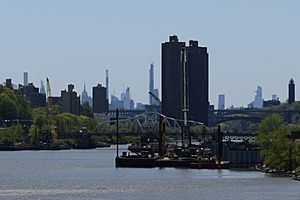
River Plaza, a shopping mall, opened in August 2004. It is the main shopping area for Marble Hill. It cost $90 million to build and has a large parking lot on its roof. The mall was designed so people could still see famous landmarks like the George Washington Bridge and the Empire State Building.
Fire Safety
The New York City Fire Department (FDNY) has a fire station nearby that serves Marble Hill. In 1895, the Marble Hill Hose Company was formed because there was no fire station in the neighborhood. It was the only independent fire company in Manhattan for ten years.
Education in Marble Hill
Schools in the Area
John F. Kennedy High School was built in the old riverbed on the west side of Marble Hill. It opened in 1972. Due to academic issues, the school closed in 2014. Now, six smaller high schools use its campus.
The closest public elementary school is PS 7 Milton Fein School in Kingsbridge. Nearby private schools include Horace Mann School and Riverdale Country School. The Marble Hill Nursery School is also located in the Marble Hill Houses.
Library Services
The New York Public Library (NYPL) has the Kingsbridge branch at 291 West 231st Street.
Transportation Options
The Marble Hill train station was built in 1905–1906. It is served by the Metro-North Railroad's Hudson Line. This line connects Marble Hill to Grand Central Terminal in midtown Manhattan and other areas.
The New York City Subway also serves Marble Hill. The Broadway–Seventh Avenue line was extended to 242nd Street in 1906. The 225th Street station is part of this line.
The main street running through Marble Hill is Broadway, which is part of U.S. Route 9.
Politics and Identity
The United States Census Bureau officially considers Marble Hill as part of New York County. This means residents who serve on jury duty go to courthouses in lower Manhattan.
Political Representation
Marble Hill is part of New York's 13th congressional district. It is also in the 31st district for the New York State Senate and the 72nd district for the New York State Assembly. The New York City Council's 10th district represents it. The local community board for Marble Hill is Bronx Community Board 8.
History of Political Debate
For many years, there was confusion about whether Marble Hill belonged to Manhattan or the Bronx. In 1939, the Bronx Borough President even tried to claim Marble Hill for the Bronx as a publicity stunt. Residents of Marble Hill wanted to stay part of Manhattan.
In 1984, a judge ruled that Marble Hill was part of both the Borough of Manhattan and Bronx County. Later that year, the New York Legislature passed a law to make it clear that Marble Hill is part of New York County and the Borough of Manhattan.
Local Services
Even though Marble Hill is legally part of Manhattan, many city services come from the Bronx. This is because it's easier and safer, as the only road connection to the rest of Manhattan is a lift bridge, the Broadway Bridge. For example, fire and police departments come from the Bronx. However, medical services are provided from Manhattan Island.
Marble Hill shares a ZIP Code (10463) with parts of the Bronx. The "104" prefix is usually for Bronx areas. Also, Marble Hill uses Bronx area codes 718, 347, and 929, which are overlaid by the citywide area code 917. Residents are listed in both Bronx and Manhattan phone books.
Notable People from Marble Hill
Some well-known people who have lived in Marble Hill include:
- Ted Corbitt (1919–2007), a famous long-distance runner.
- Guillermo Linares (born 1951), a politician.
- Justin Pierce (1975–2000), an actor and skateboarder.
|
See also
 In Spanish: Marble Hill (Nueva York) para niños
In Spanish: Marble Hill (Nueva York) para niños


